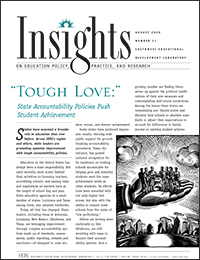States' Capacity to Deliver
States place a great deal of emphasis on state-level assistance and intervention in schools or districts that aren’t able to meet standards. Today, 19 states mandate that low-performing schools receive state assistance. States’ actual capacity to deliver the personnel, expertise, and funding that these schools need to improve their practices, however, often can and does fall short (Elmore, Abelmann, & Fuhrman, 1996).
States’ new, more systemic responsibilities can be challenged by the costs required to meet their accountability goals. Although some states claim to be leaner and smarter–Texas Education Agency (TEA), for example cut its personnel by 14 percent between 1980 and 1998–change is a human-intensive activity. To provide the technical assistance it promised schools, TEA contracted with 20 educational service centers, which operate on a combination of federal, state, and local money.
The situation is similar in other states. Sanctions and rewards don’t come cheaply. Kentucky reports spending about $110,000 a year to assign experienced educators to work closely with schools designated "in crisis." At the other end of the spectrum, since 1995, it has spent more than $54 million in rewards directly to teachers and administrators (Fuhrman, 1999).
Some school officials now acknowledge, however, that they may have been asking for too much too soon. Accountability systems carry a high price tag. Hampered by the lack of funds, many state and local officials have been unable to put into place the technical assistance staff, professional development programs for teachers, extra help for students, and the other support necessary to meet suddenly accelerated standards. In some states, just getting the data to school districts in time for the information to be useful in planning has been a problem. In others, sufficient resources with which to train principals and teachers to analyze student performance data just aren’t there. Before states can hold students, teachers, and principals accountable, they must have the capacity to deliver their own part.
Safeguarding Accountability Systems
One consequence of the added pressure on school administrators and teachers to put forth their best performance on school tests has been the manipulation of accountability systems. The media have reported instances of blatant cheating by teachers and administrators, but documented cases remain few.
Nonetheless, states have created new safeguards to protect both their test items and individual student test scores, going so far as to make student record tampering by school system employees a criminal offense. In most states, security is so important that testing officials go to great lengths to protect the integrity of their systems. Many are holding workshops on test security for teachers and other school employees. In May 1999, the Texas state legislature passed a bill that makes it a felony to alter tests or test results. Those found guilty could spend up to 10 years in prison and pay up to $10,000 in fines. The action came on the heels of allegations that school employees in several districts had altered student information, including scores on the state assessment, to boost school ratings. Several teachers and staff resigned as a result and principals were severely reprimanded. Similar charges of test tampering have been levied against educators in districts around the country.
Next Page: States' Continuing Role

